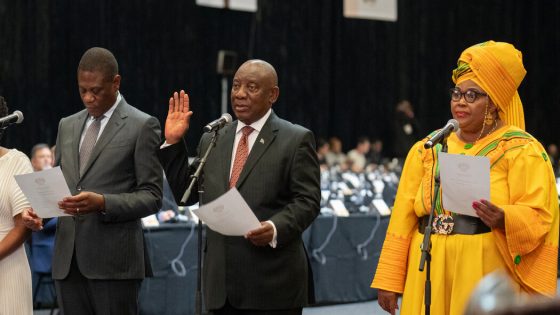After South Africa’s president announced the largest cabinet in the nation’s democratic history on Sunday, some critics were questioning whether the attempt to pacify diverse political interests would complicate efforts to tackle the country’s myriad economic and social problems.
President Cyril Ramaphosa had for years promised to shrink the size of government — partly because of demands by the public and political opponents. But with his party, the African National Congress, having failed in the recent election to secure an absolute majority in Parliament for the first time since the end of apartheid 30 years ago, he has had to incorporate a broad coalition of parties in his executive.
He increased the number of cabinet ministers to 32 from 30, and the number of deputy ministers to 43 from 36. The combined 75 ministers and deputy ministers is the most in any administration since the first democratic election in 1994. Now comes the challenge of bringing together this diverse array of politicians to form a coherent policy agenda for a nation struggling with high unemployment, entrenched poverty and the shoddy delivery of basic services.
“So every political party had a thorough critique of an unnecessarily bloated cabinet up until the choice was between a bloated executive or their party member not receiving” a position, Moshibudi Motimele, a political studies lecturer at the University of the Free State in South Africa, wrote on social media.
“I repeat,” she added, “the politics being played here is about power and positions and absolutely nothing to do with people and policy.”
But Mr. Ramaphosa and the leader of the second-largest party, the Democratic Alliance, have insisted that the executive formed out of about a month of negotiations following the election in May will work together to set South Africa on the right path.
“While the ministers and deputy ministers who make up the national executive come from different parties, they will be expected to serve the people as a whole,” Mr. Ramaphosa wrote on Monday in his weekly letter to the nation. “They will be expected to implement a shared mandate and a common program of action.”
Mr. Ramaphosa’s cabinet was sealed after two weeks of tense negotiations between his party, the A.N.C., and the Democratic Alliance that included moments in which their partnership seemed on the verge of collapse.
The A.N.C. won 40 percent of the vote in the election, while the Democratic Alliance got 22 percent. But the two parties clashed over how many ministerial posts the Democratic Alliance was supposed to get, per an agreement to work together that both sides had signed in mid-June. That agreement formed what they are calling a government of national unity that now includes 11 of the 18 parties in Parliament, participating in an A.N.C.-led governing coalition.
While the A.N.C. invited all parties in Parliament to join the unity government, the third largest party, uMkhonto weSizwe, led by former President Jacob Zuma, declined. With more than 14 percent of the vote, Mr. Zuma’s party will lead an opposition coalition.
In the end, the Democratic Alliance got six ministers and six deputy ministers. The Inkatha Freedom Party, the third largest in the coalition, got two ministers, while the Patriotic Alliance, Freedom Front Plus, Pan Africanist Congress of Azania and GOOD parties got one each.
“The D.A. was never in this for positions for their own sake,” John Steenhuisen, the leader of the Democratic Alliance, said in an address on Monday. His party “refused to accept watered-down compromises,” he added, in order “to ensure that the portfolios we get are of real substance.”
“Our commitment is to painstakingly rebuild the government institutions now under our custodianship,” he said.
Mr. Steenhuisen was given the role of agriculture minister. That ministry previously included land reform and rural development, but Mr. Ramaphosa made land reform a separate ministry and named the leader of the Pan Africanist Congress, Mzwanele Nyhontso, as minister.
This sets up an interesting dynamic, as Mr. Nyhontso’s party has, in its manifesto, strongly promoted “the restoration of land” to Black people dispossessed through colonization. The Democratic Alliance has argued generally for increasing land ownership opportunities for South Africans, but not through the lens of racial justice.
Increasing land ownership among Black South Africans — or land reform, as it is called — will likely take coordination between Mr. Steenhuisen’s and Mr. Nyhontso’s ministries. Once land is transferred, new owners often need financial support from the agricultural department so that they can farm effectively.
“If we don’t move with speed on land reform, we may not be able to achieve the extra growth as well as inclusiveness on the agriculture side,” said Wandile Sihlobo, a South African agricultural economist.
Ms. Motimele of the University of the Free State said in an interview that while forming a cabinet was high stakes, the most critical moment for the country comes now in creating and enacting policies.
“This is the moment,” she said, “in which social movements, civil society, ordinary South Africans can now get involved in shaping what takes place.”
Source Agencies


